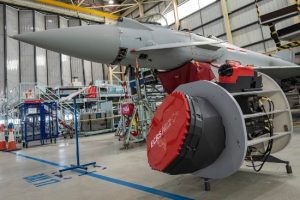The latest prototype of the radar flew this week on a UK Typhoon test and evaluation aircraft, the BS116, highlighted Leonardo. This was part of ongoing development programme for the UK Typhoon fighter aircraft, designed to be part of NATO’s frontline fleet.
The radar electronics feature a multi-functional array (MFA) that can perform both traditional radar functions, such as search and targeting, as well as additional electronic warfare tasks. It is designed that the RAF pilots will be able to locate and deny use of an adversary’s radar with electronic jamming while staying beyond the reach of threats.
“The development of the ECRS Mk2 is fully utilising the UK’s world-class radar design skills,” said Tim Bungey, Chief Engineer for ECRS Mk2 at Leonardo UK.
“Over the past few months, its Processor, Receiver, and Antenna Power Supply and Control (APSC) units have all been re-engineered from the prototype design to further enhance the capacity, capability, and performance of the Mk2 system in alignment with the new antenna and electronic warfare capability.”
The ECRS Mark 2 was made in Edinburgh.
The first flight follows a programme of integration and ground-based testing involving collaboration between the MoD’s Defence Equipment & Support (DE&S) and the RAF, as well as Leonardo UK and BAE Systems. Leonardo first delivered an ECRS Mk2 radar to BAE back in April 2023.
Typhoon
For its part, the DE&S highlighted the importance of the radar to the Typhoon.
“This is another landmark moment in this strategically important programme which will provide the RAF with battle-winning technology that gives them the edge to protect the nation,” said Nick Moore, Typhoon DepHd Capability Acquisition at DE&S. “The ECRS Mk2 radar will further transform Eurofighter Typhoon’s control of the air and provide exceptional capability our adversaries will struggle to match.”
Image: Leonardo – The Typhoon test and evaluation aircraft shown alongside a scale model of the ECRS Mk2 radar.
See also: Leonardo turns to AI to handle future combat air mission data

